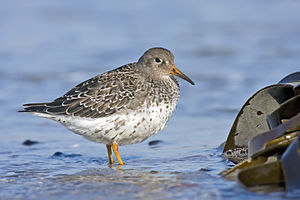Sandpipers
| Sandpipers | ||||||||||
|---|---|---|---|---|---|---|---|---|---|---|

Sandpiper ( Calidris maritima ) |
||||||||||
| Systematics | ||||||||||
|
||||||||||
| Scientific name | ||||||||||
| Calidris maritima | ||||||||||
| ( Brünnich , 1764) |
The sandpiper ( Calidris maritima ) is a monotypical species of bird from the family of snipe birds (Scolopacidae). It is a breeding bird of the far north of Eurasia and North America. In Central Europe he is a regular migrant and winter visitor during the migration period . The winter population is a few hundred individuals on the coasts of the North and Baltic Seas.
description
The sandpiper is slightly larger than the dunlin . It reaches a body length of 20 to 22 centimeters. The wingspan is between 38 and 44 centimeters. The males weigh between 52 and 94 grams. The females weigh between 60 and 105 grams. Characteristic of these arctic sandpipers are the yellow legs and the yellow base of the beak. In the plain dress, the top is a solid gray-brown, the bottom is light.
distribution
Purple sandpipers are only migrants in Central Europe, their breeding areas are in Arctic America , Greenland , Jan Mayen , Iceland and Spitsbergen as well as in northern Scandinavia and Asia . The sandpiper is a short-distance migrant and partial migrant . The extent of the migration of breeding birds in the southern Arctic is not yet sufficiently clear. The breeding birds of Western Canada overwinter on the west coast of the USA, in southeast Greenland and in Iceland and may also reach Great Britain during their migration. Greenland's breeding birds migrate to Iceland and northwestern Europe, while Iceland's breeding birds appear to be resident birds . The breeding birds of Siberia and Svalbard migrate to Norway and Great Britain. The breeding birds of Norway also overwinter in Great Britain.
In the far north, the breeding birds leave their breeding areas from mid-August to mid-September. The first migrants arrive at the North Sea from mid-August. The influx of wintering birds can continue until mid-winter. The breeding birds return to their breeding areas from mid-April to late May.
Purple sandpipers prefer to stay on rocky coasts during the migration .
Reproduction
Purple sandpipers probably reach sexual maturity in the first year of life. They lead a monogamous brood marriage. The nesting place is usually found on dry ground. The nest hollow is relatively deep and laid out with a lot of plant material. The male alone builds it. Laying begins in the south of the distribution area from the 1st May decade. Farther north you can find full meshes from around June 10th. The eggs are top-shaped with a variable color. The basic color varies from pale to light olive green or blue-green. The skin has light to dark brown spots. The incubation period is 21 to 23 days. Both parent birds breed. The young birds are looked after by the male and are independent after 21 to 28 days.
Duration
At the beginning of the 21st century, the European breeding population was 28,000 to 75,000 breeding pairs. The largest populations live on Iceland (10,000 to 30,000 breeding pairs), on Greenland (10,000 to 20,000 breeding pairs) and Norway and Svalbard (together 7,000 to 20,000 breeding pairs) and Sweden (1,000 to 3,000 breeding pairs). 50,000 to 100,000 individuals overwinter in north to south-west Europe.
supporting documents
literature
- Hans-Günther Bauer, Einhard Bezzel and Wolfgang Fiedler (eds.): The compendium of birds in Central Europe: Everything about biology, endangerment and protection. Volume 1: Nonpasseriformes - non-sparrow birds. Aula-Verlag Wiebelsheim, Wiesbaden 2005, ISBN 3-89104-647-2 .
- Richard Sale: A Complete Guide to Arctic Wildlife , published by Christopher Helm, London 2006, ISBN 0-7136-7039-8
Web links
- Calidris maritima in the endangered Red List species the IUCN 2008. Posted by: BirdLife International, 2008. Accessed January 31 of 2009.
- Videos, photos and sound recordings on Calidris maritima in the Internet Bird Collection
- Purple sandpiper feathers


